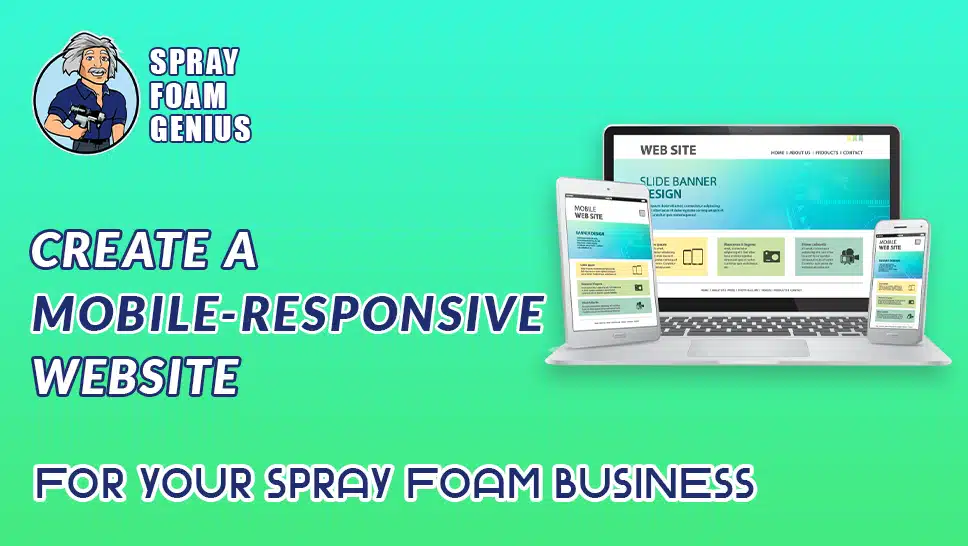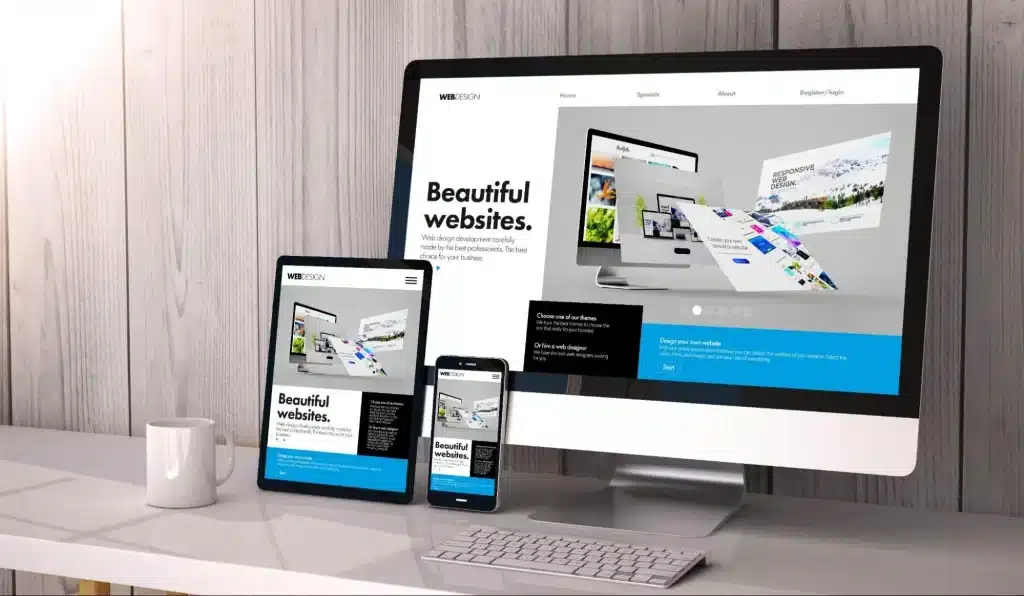
In the modern digital landscape, where mobile internet usage surpasses desktop, having a mobile-responsive website is essential for any business. For spray foam insulation contractors, this means ensuring that your website for spray foam business functions seamlessly across all devices, from smartphones to tablets. A mobile-responsive site not only improves user experience but also boosts your search engine rankings and drives more conversions. This guide from Spray Foam Genius Marketing will walk you through the essential steps to create a mobile-responsive website tailored specifically for your spray foam business.
The Importance of Mobile Responsiveness
Understanding Mobile Traffic Trends
With over 50% of global web traffic originating from mobile devices, it is imperative for spray foam contractors to cater to mobile users. This trend indicates that your potential clients are likely to be browsing and searching for services on their smartphones or tablets. A mobile-responsive website ensures that these visitors have a smooth and engaging experience, which can significantly impact your business’s online success.
Enhancing User Experience
A mobile-responsive design adapts to various screen sizes and orientations, ensuring that your website looks and functions well on any device. This adaptability leads to a more enjoyable user experience, reduces frustration, and increases engagement. A well-designed mobile experience can lead to higher client satisfaction and increased retention rates, ultimately benefiting your business.
Boosting SEO Performance
Google’s algorithms prioritize mobile-friendly websites, making mobile responsiveness a critical factor in search engine optimization (SEO). A website that performs well on mobile devices is more likely to rank higher in search results. By optimizing your website for mobile, you enhance your chances of being found by potential clients who are searching for spray foam insulation services.
Key Steps to Creating a Mobile-Responsive Website

1. Know Your Audience
Understanding User Behavior
Before you start designing your mobile-responsive website, it’s essential to understand how your target audience interacts with the web. For spray foam contractors, this involves identifying whether your clients primarily use smartphones, tablets, or desktops. Tools like Google Analytics can provide valuable insights into your audience’s device preferences and browsing habits, helping you make informed design decisions.
Competitive Analysis
Analyzing the websites of your competitors can provide useful insights into what works well and what doesn’t in the spray foam industry. Look at how they present their services, their mobile site design, and user engagement. This analysis will help you identify best practices and design a website that stands out from the competition while meeting the needs of your target audience.
2. Choose the Right Platform
Responsive Web Design (RWD)
Responsive web design is a design approach where your website’s layout and content adjust automatically based on the user’s device. This ensures a consistent and optimal experience across all devices, from desktops to mobile phones. Popular content management systems (CMS) like WordPress, Joomla, and Drupal offer responsive themes and templates that can simplify the design process.
Selecting a CMS
When choosing a CMS, consider factors such as ease of use, flexibility, and support for responsive design. WordPress is a popular choice due to its extensive range of responsive themes and plugins. Ensure that the CMS you choose allows for easy updates and maintenance, and supports the specific needs of your spray foam business.
3. Design for Mobile First
Simplify Navigation
Mobile users appreciate simplicity and ease of navigation. Design a clean and intuitive menu that allows users to find information quickly. Avoid clutter and ensure that navigation elements are easily accessible. A well-organized menu with clear labels will enhance the user experience and make it easier for visitors to explore your website.
Optimize Images and Media
Large images and media files can slow down your website’s loading times on mobile devices. Use image compression tools to reduce file sizes while maintaining quality. Consider using scalable vector graphics (SVGs) for icons and logos, as they are resolution-independent and ensure a crisp appearance on all screen sizes.
Ensure Touch-Friendly Design
Interactive elements such as buttons and links should be designed with touch interactions in mind. Ensure that these elements are large enough to be tapped easily and that there is adequate spacing between them to prevent accidental clicks. Forms should be easy to fill out on mobile devices, with appropriately sized input fields and buttons.
4. Improve Speed and Performance
Fast Loading Times
Mobile users expect fast loading times. Optimize your website’s performance by minimizing HTTP requests, using a content delivery network (CDN), and implementing caching strategies. Tools like Google PageSpeed Insights can help you identify performance issues and suggest improvements to enhance loading times.
Testing Across Devices
To ensure consistent performance, regularly test your website on a variety of mobile devices and browsers. Use tools like BrowserStack or TestComplete to simulate different devices and identify potential issues. Continuous testing helps ensure that your site performs well across all platforms and provides a seamless experience for all users.
5. Optimize for Local SEO
Enhancing Local Search Visibility
Local search optimization is crucial for spray foam contractors who rely on local clients. Ensure that your website includes location-specific keywords relevant to your service areas. Create and optimize a Google My Business profile to improve your local search presence and make it easier for clients to find your business online.
NAP Consistency
Maintain consistent Name, Address, and Phone Number (NAP) information across your website and local directories. This consistency helps search engines verify your business location and improves local SEO. Ensure that your NAP information is accurate and up-to-date on all online platforms.
Encourage Reviews and Testimonials
Positive reviews and testimonials can enhance your credibility and attract more clients. Encourage satisfied clients to leave reviews on your Google Business Profile and other review sites. Display these reviews prominently on your website to build trust with potential clients and showcase your expertise.
6. Implement Conversion Optimization Strategies
Effective Calls-to-Action (CTAs)
Guide visitors towards desired actions with clear and compelling calls-to-action (CTAs). Whether it’s requesting a quote, scheduling a consultation, or contacting you directly, make sure your CTAs are prominently displayed and easy to interact with on mobile devices. Use contrasting colors and actionable language to draw attention to your CTAs.
User-Friendly Lead Capture Forms
Incorporate user-friendly lead capture forms to make it easy for potential clients to get in touch. Ensure that forms are easy to complete on mobile devices, with appropriately sized fields and buttons. Consider integrating click-to-call features for instant communication, allowing users to contact you directly with a single tap.
Showcase Client Success Stories
Highlight successful projects and satisfied clients to build credibility and trust. Use client testimonials, case studies, and portfolio examples to demonstrate your expertise and the quality of your work. Ensure that these elements are easily accessible and viewable on mobile devices, enhancing their impact.
7. Analyze and Refine
Monitor Performance Metrics
Use analytics tools like Google Analytics to track mobile traffic, user behavior, and conversion rates. Regularly review this data to identify trends and areas for improvement. Understanding how users interact with your site can help you make data-driven decisions to enhance performance and user experience.
Gather User Feedback
Collect feedback from users to gain insights into their mobile experience. Use surveys, feedback forms, or direct interactions to understand their needs and preferences. This feedback is invaluable for making targeted improvements and ensuring that your website meets the expectations of your audience.
Stay Updated with Trends
Mobile technology and user expectations are constantly evolving. Stay informed about the latest trends and best practices in mobile web design. Regularly update your website to incorporate new features, technologies, and design trends to keep it current and competitive.
Get Started with Your Mobile-Responsive Website
Creating a mobile-responsive website for your spray foam business is essential for reaching a broader audience and enhancing user experience. At Spray Foam Genius Marketing, we specialize in designing and developing websites that are optimized for both desktop and mobile users.
Ready to elevate your online presence? Call us at 877-840-FOAM for USA and 844-741-FOAM for Canada visit our website at sprayfoamgeniusmarketing.com, or email us at [email protected] to get started.
We look forward to helping you achieve your digital marketing goals!
- Social Media Marketing for Spray Foam Businesses: What Works in 2025? - February 6, 2025
- Best SEO Strategies for Spray Foam Insulation Contractors to Rank #1 on Google - February 6, 2025
- What is Spray Foam Insulation? Benefits and Applications - February 5, 2025

